Running Grave: Ring Reading Index
Links and Summaries of the Eleven Strike7 Ring Posts, Three Take-Aways, Value of Structural Analysis in Evaluating the Reviews of 'Running Grave'
Last week I finished my series of eleven ring-reading posts about Rowling-Galbraith’s Running Grave, her latest Cormoran Strike novel, in which series I did a structural analysis of its 944 pages using Mary Douglas’ criteria for chiasmus from her Thinking in Circles. Today I am posting a one-stop collection of links to each of these posts with a short summary of each post’s contents as well as my conclusions and take-away thoughts about the month long project for the convenience of future readers. It is the Strike7 Ring Reading Project Index; enjoy!
Running Grave Part Zero: The Prologue Ring Reading
I met Nick Jeffery every week via Skype during this project and during one of these conversations we realized that the six parts of the Prologue (it is only one chapter) worked as a ring. I was neck deep in the analysis of the Parts, so Nick agreed to write up his notes on the subject. The ‘meaning in the middle,’ an exchange of letters and emails from lawyers? “That the law is helpless in aiding the injured but can be easily weaponized to serve the powerful.”
Running Grave Part One: A Ring Reading
I explain the goal of the project in this post, introduce the essentials of ring composition that will be used in every post, use them to break down the near perfect ring of Part One, and then break out the Quadriga tools to lay out the first Part’s four level of meanings. Highlights include the mythological content (Strike as Eros shooting himself with arrows!), the allegorical and psychomachean content in characters named Will and Prudence, and the pointers to Charlotte’s likely death. The meaning in the middle? We’re all living in a postmodern mind-control cult, Plato’s cave, and Robin and Cormoran are blissfully oblivious of this fact.
Running Grave Part Two: A Ring Reading
The structural analysis of each Part of Strike7 continues with Part Two and reveals how the antiphonal, back-and-forth chapters of robin-then-Strike-then-Robin Parts of the book are going to work. The meaning in the middle is Abigail Glover (!) and of course I missed what that was really about. Interesting observations, though, about Sherlock Holmes and Conan Doyle, the nigredo touches (especially that raven at Strike’s window), and an alternative structural reading.
Running Grave Part Three: A Ring Reading
Part Three also proved to be a ring of antiphonal Robin-Strike chapter sequencing (check out those colors!). I discuss for the first time the macroscopic ring of the novel, the relation of its Parts, beyond the individual Parts as rings. Highlights of this post include a review of the several plot lines, angst that we are being set-up for Charlotte’s death, another Sherlock Holmes point, and the laugh-out-loud improbability of Robin’s polaroids discovery if there are no ghosts involved.
Running Grave Part Four: A Ring Reading
I noted in this look at Part Four that no one will ever think of these Strike7 chapters as anything other than ‘Charlotte’s Suicide.’ I argue that the last four chapters, Striker’s trip to Comer, are an A-B-B’-A’ chiasmus and the cross at the center of the novel, which, given the prominence of Charlotte’s place in the Epilogue’s three chapters (she is the heart of the last two), seems to have been spot-on. I fall here, unfortunately, into the Delauneys-Did-It Trap that Rowling sets with predictably comic results.
Running Grave Part Five: A Ring Reading
Part Five is the ‘natural center’ of a nine piece ring because it will have four parts before and after it. The highlight of this analysis, after the charting of its chapters as a ring, is discussion of the chapter that is its center, the turn of Part Five and of the novel, the chapter 71 kitchen scene in which Will quotes Christian and Hindu scriptures to Robin and Noli. I suggest that the message of this chapter is the ‘meaning in the middle’ of Running Grave, a theory that the ending did not contradict.
Running Grave Part Six: A Ring Reading
Part Six is the first Part of the ‘back half’ of the novel which means, if the novel is a ring, it should have parallels or reverse echoes with Part Four. I explain how Robin’s decisions and experiences in Part Six, especially with respect to her relationship with Strike, reflect Charlotte’s in Part Four. The ring of Part Six, especially the out-of-their-minds latch and its tie to the turn, that is, the chapter that Robin is released from the box and is taken to Jacob, reveals Rowling’s message in allegory about life in a cancel culture cave. Plus a long look at the Kevin Pirbright recording in which I miss the hidden killer…
Running Grave Part Seven: A Ring Reading
Part Seven’s chapters are viewed as reverse images of Part Three, the ring elements of Part Seven are parsed and displayed, and Carrie Woods’ break-down about Daiyu’s death and specifically her use of the word “Real” leads to a review of Rowling’s previous uses of that word in her work. I nail the straw Daiyu doll diversion at Comer Beach but continue down the Delauney false trail.
Running Grave Part Eight: A Ring Reading
The twenty-one chapters of Part Eight make it the longest (if not by number of pages) and the thrills abound with Strike confronting the Cult Leader mano a mano, a car chase with a mad gunman, and a meeting between cult survivors in which Robin reveals the magic trick behind their deluded belief in the Drowned Prophet. Discussing the meaning of this Part’s structure, I lay out first the numerous and often funny parallels between Parts Two and Eight for the book ring and then discuss the latch, turn, and turtleback lines within Part Eight. The Meaning in the Middle? Robin’s return to rationality and transformation into an Agency full partner is complete in her coming to terms with ‘Doing the Job.’
Running Grave Part Nine: A Ring Reading (A)
The finale features the Agency preparations to convince the Metropolitan Police to raid the UHC campuses and to confront and capture both the cult leadership in their London Temple offices by Robin and the killer of Daiyu Wace by Strike. It’s a short chapter set by number of chapters and in pages, but it is so rich in structural meaning that I had to write two posts to cover it all. The (A) post is the analysis of Part Nine as a ring composition unto itself, its latch, turn, and turtle-back lines. Robin’s hearing the baby’s cry and subsequent finding of the “hidden door” leads to a discussion of the Part’s ‘Meaning in the Middle,’ the symbolism of Mama Mazu’s “mother-of-pearl fish pendant.”
Running Grave Part Nine: A Ring Reading (B)
Every other Rowling novel or screenplay I have charted as a ring composition has been, with the partial exception of Troubled Blood, entirely about the whole book read as a ring rather than the rings to be found in the whole’s interior parts. This second part of my analysis of Running Grave’s Part Nine, the (B) section, is the reading of Strike7 as a ring composition with the Latch made up of Parts One, Nine, and Epilogue, the turn being in the end of Part Four and all of Part Five, and the turtle-back lines being those between Parts Two and Eight, Three and Seven, and Four and Six. It includes, if I say so myself, important points about the Eros/Anteros divide as well as the soul-and-spirit psychomachia in the Strike series, book seven being that series’ ring-latch/close in several respects, and about Robin’s roles in it as Godmother, Mid-wife, Abortionist, and Artemis avenger and protector of children, roles that are structurally highlighted by their appearance at the story’s beginning, middle, and end. I conclude with notes about the bracket relationships between the opening epigraphs and the Credits and between the Prologue six chapter ring and the six piece chiasmus of the Acknowledgements page.
It ends with a marker about the only piece of Running Grave without a corresponding part or page, the dedication to her three oldest friends, Rowling’s ‘Secret Keepers,’ I think, with an in-joke perhaps about her being ‘Artemis’ to them. More anon about the author’s greatest secret and its relevance for understanding everything she writes.
Three Take-Aways
Let me confess that I am delighted to have finished this work as promptly as I have and as thoroughly as I could have hoped. In little over a month I have charted each Part of Running Grave as a ring and discussed its ring structure as a whole. The largest piece that needs to be done now is with the first seven books as a ring, noting its echoes with Cuckoo’s Calling and the parallels between that first-and-last latch and the series turn in Part Four. As Rowling has succeeded in obscuring that ring in her extending the series another three books, there is very little pressure to make those connections and, in fact, significant incentive to neglect it (who likes being ignored or dismissed as a crank?). Still, the seven book ring is fairly obvious — the turtle-back lines between books two and six as well as three and five, have already been drawn, and the connections between Cuckoo’s Calling and Lethal White already delineated (‘Part Two’ anyone?) — and I will write up those notes in due time.
My hypothesis as I started out on this eleven, now twelve part exegesis of the structure of Running Grave was in three parts, namely that:
Running Grave is a Ring Composition
Each of Running Grave’s Nine Parts is a Ring Composition
The Author’s Structural Artistry is Key to Understanding Her Message and Meaning
For reasons I discussed at the end of Part Nine (B), as thorough and complete as I have been in this first look, these three ideas have to be considered as unproven or still hypothetical. Reading the book through one lens exclusively, however valuable it has proven in reading Rowling’s work previously, and being personally involved in the results of the exegesis — how embarrassing would it be for me if only a few of the Parts were rings or if Strike7 didn’t ‘work’ as a ring? — means my findings have to be taken with some skepticism. Until someone attempts to read the book through the same lens or with a different one which confirms the value of my reading (and, alas, I don’t know anyone today among Rowling readers or Strike fandom with the skills or interest to attempt that), it will remain a challenging idea or argument rather than anything proven or established.
I’m convinced, of course, and I do think that this structural analysis is very helpful in responding to reviewers of Running Grave, the great majority of which make the same observations and criticisms. If they were even slightly aware of Rowling’s chiastic artistry, the failings they find in her writing would be understood differently.
What Reviewers Have Missed Because They Do Not Care About Structure
“It’s Too Long.”
The most common complaint, especially among the chattering class that write book reviews for print newspapers or online after a single hurried reading, is that Running Grave, as with the last three Strike novels, at well over nine hundred pages is too long. Rowling once observed that Order of the Phoenix needed some cuts but she didn’t know where she’d make them. Having charted the fifth and longest Harry Potter novel, her point is an important one.
Any cuts mean taking out resonating chapter parallels across the story axis and the weave of the book read as a woven tapestry.
The same is at least as true in Running Grave which is several orders of complexity greater than Order of the Phoenix in its structural ambitions If a reader is blind to a writer’s structural artistry, though, an essential quality of the writer’s intention, what value can be attributed to that reader’s evaluation of the quantity of pages in a given work?
My answer to that rhetorical question, is, of course, “Not much value.”
“There are Too Many Characters.”
I confess to being much more sympathetic to this complaint. I was reading Running Grave very slowly; it took me the greater part of a month to finish my first reading because I was charting and writing about each of its nine Parts as I read each one. Slow as I was going, however, I still occasionally stopped and said, “Who is that?” When the number of new characters crosses the thirty mark, a reader can be forgiven for some confusion, even bewilderment. Rowling’s telling the story of three communities at Aylmerton — during Strike’s year there, during Daiyu’s time of death, and while Robin was there undercover — is necessarily complicated and crowded even with multiple characters.
That being said, reading the book slowly, even as a series of nine books or episodes (like a Dickens novel as published!), rather than as a novel read in the same way one would a short story or novella, largely eliminates this problem, if not completely. Reading it with an eye to structure, in which these characters in their various communities exist in parallel across the Parts of the book-ring, makes it even easier to keep the Dramatis Personae in one’s head.
“Rowling Needs an Editor.”
I’m even more sympathetic to this criticism, of course, after a long, slow reading than I usually am. The gaffes and unforced errors in the story line, not to mention the plot point absurdities — Ronin’s finding the polaroid pictures in a cookie tin, the meetings with Lin at the property blind-spot, come to mind immediately — really just out at you when you’re not rushing to the finish line to find out whodunnit. It’s become something of a side recreation for Strike fans to find the mistakes a copy editor should have picked up.
Acknowledging that — and expressing nothing but our sympathy, even condolences for Rowling’s long-suffering copy editor (imagine what the books would be without Nithya Rae’s efforts!) — if Rowling’s books are read with at least one eye on her structural artistry and its complex weave, the numerous errors and imagination stretchers to be found in each fall away in importance. That kind of precision is not Rowling’s priority, clearly; the Shed work she does is much more involved, I think it fair to say, in the allegorical or archetypal meaning and symbolism she is working into her stories and the complementary structural component to those depths, story scaffolding of remarkable consistency and complexity.
All of that is invisible to the great mass of readers, of course, the structure and the symbolic depths, and the inevitably rich literary allusion, but when one has some appreciation of that accomplishment, then the surface failings of her story telling — the length of the work, the number of characters, the unforced errors — come off as trivial. If literary criticism properly done is a creative act akin to the author’s, then this kind of fault-finding is little more than keeping score or admitting one’s own limitations or failing as a reader.
I hope that my work in drawing out Rowling’s ring artistry helps readers come to a greater appreciation of her writing — and less prone to complain about the inevitable and trivial failings in her reaching at such a target, writing a work that works in a ring cycle, as a ring itself, and whose interior chapter sets or Parts are rings-within-those rings.
Your comments are coveted and appreciated. Have at it in the boxes below.

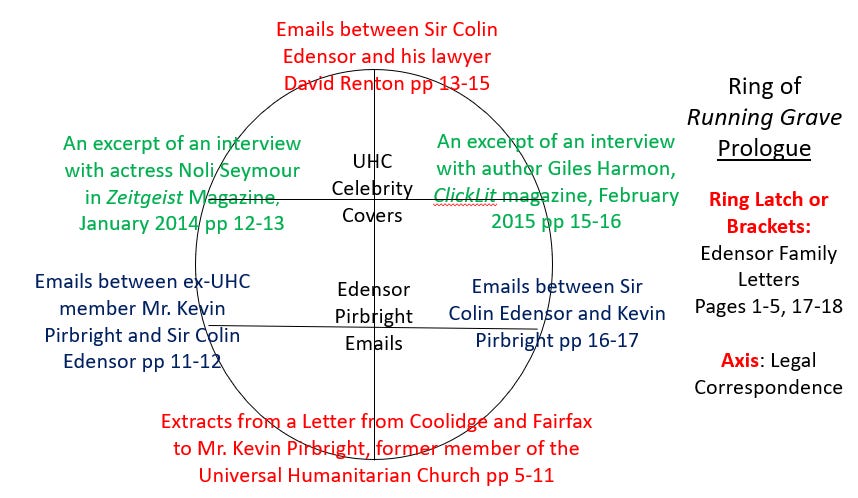
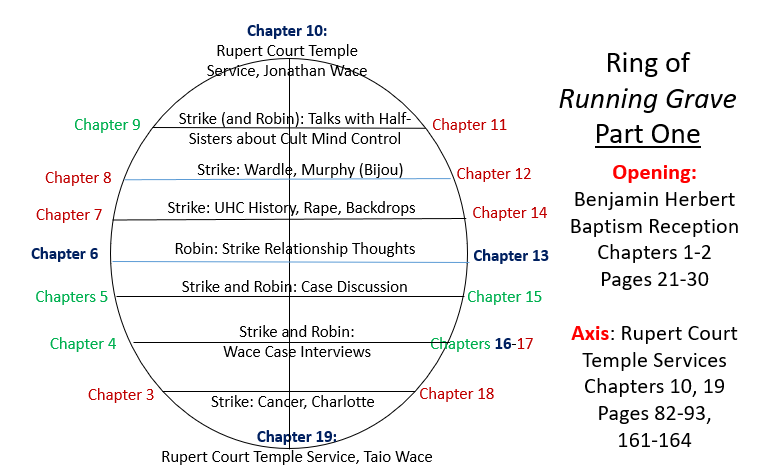
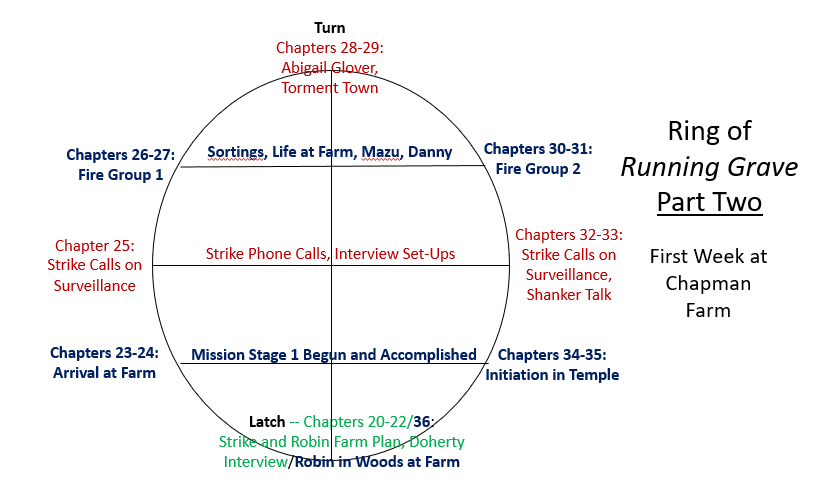
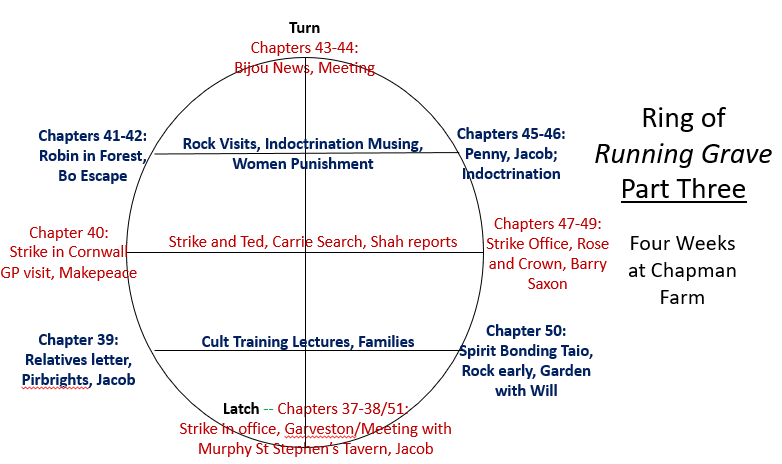
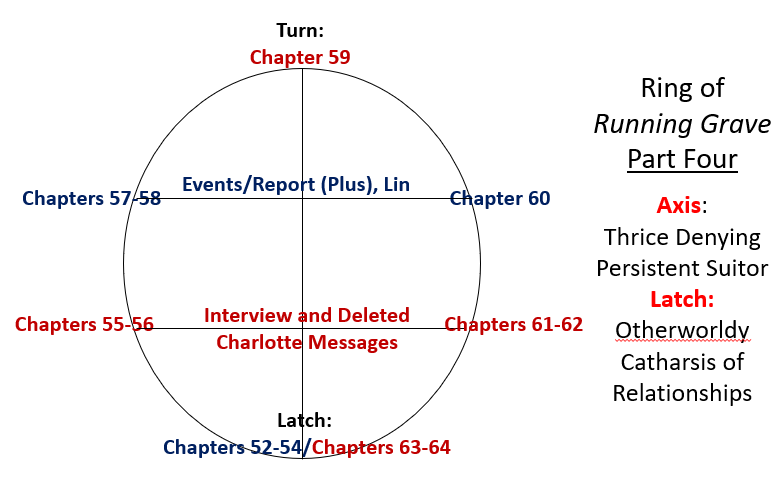
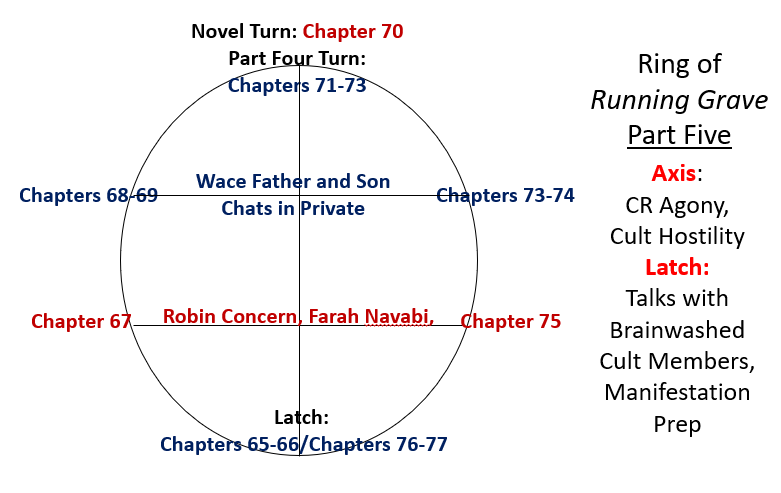
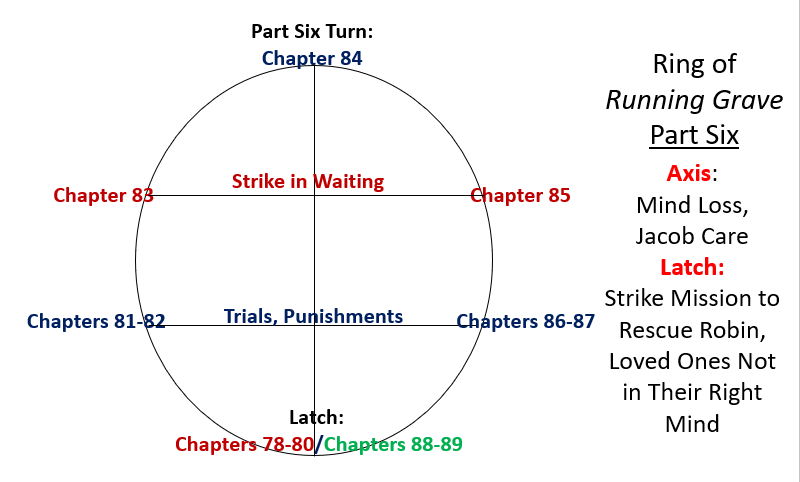
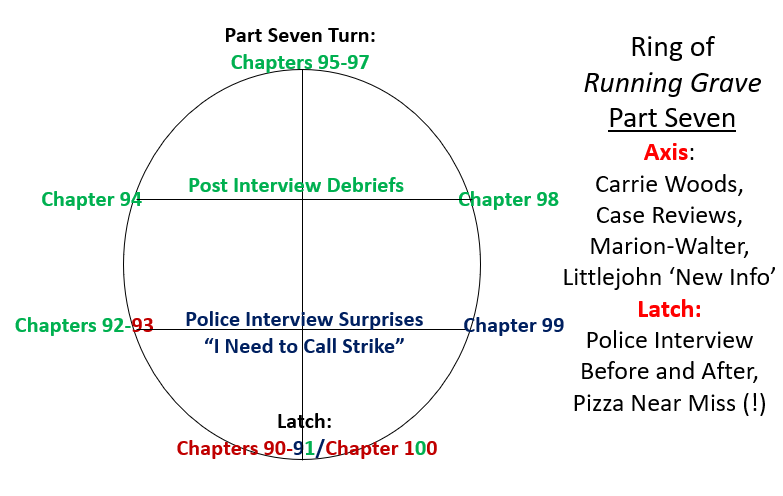
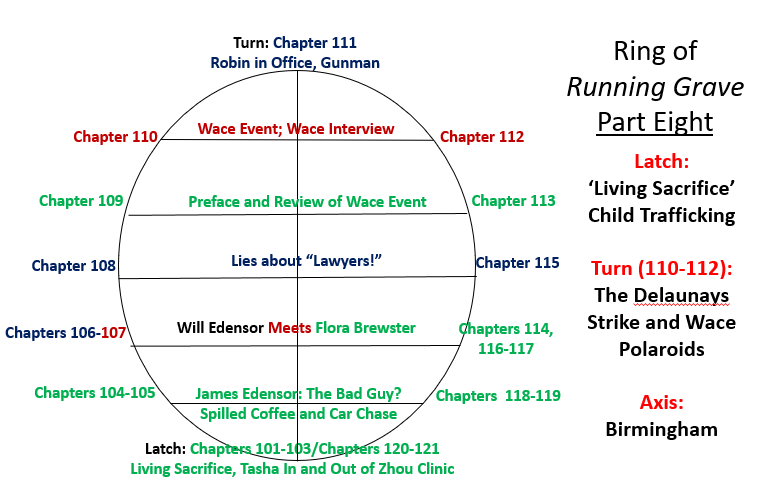
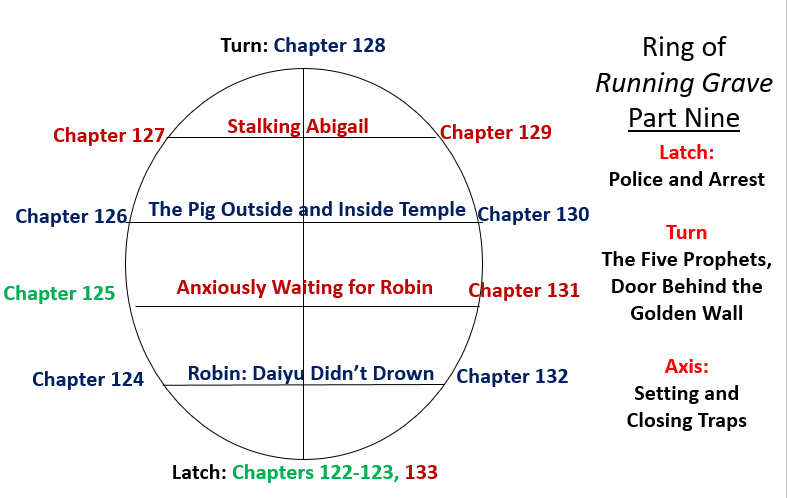
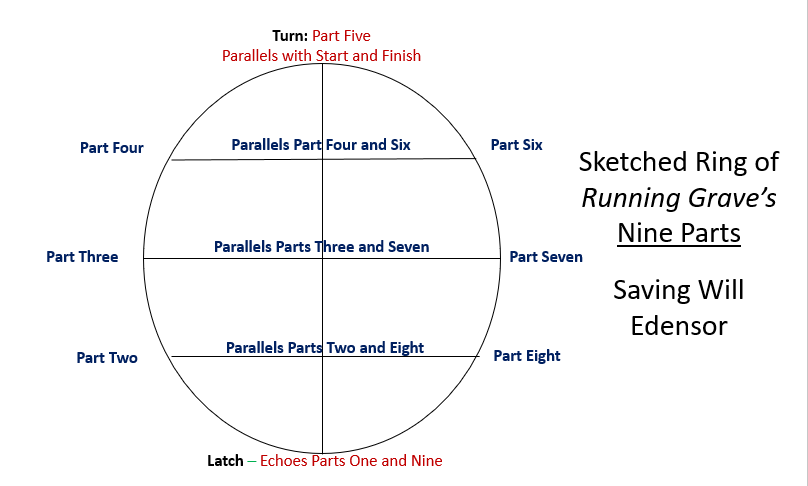

John, first hats-off for the prodigious effort to organize this material into ring structures. I’ve read all of your posts and, while I can’t pretend to see all of the linkages you describe, you’ve helped me see many that clearly exist and make Rowling/Galbraith’s achievement all the more impressive.
A couple points where we may may not be in sync:
I don’t agree that Strike “all but kills” Charlotte by not reporting her suicide threats. He’s heard them before as, I suspect, most people in her life have. People with Borderline Personality Disorder, which Charlotte’s almost certainly suffers from, are among the greatest challenges for mental health professionals. They can be extremely unstable emotionally, are resistant to psychotherapy, unimproved by medication and may exhibit the following symptoms (from Wikipedia, for expedience):
* Frantic efforts to avoid real or imagined abandonment
* Unstable and chaotic interpersonal relationships, often characterized by alternating between extremes of idealization and devaluation, also known as “splitting”
* Markedly disturbed sense of identity and distorted self-image
* Impulsive or reckless behaviors (e.g., uncontrollable spending, unsafe sex, substance use disorders, reckless driving, binge eating)
* Recurrent suicidal ideation or self harm
* Rapidly shifting intense emotional dysregulation
* Chronic feelings of emptiness
* Inappropriate, intense anger that can be difficult to control
* Transient, stress-related paranoia or severe dissociative symptoms
Sound familiar? Tragically, up to 10 percent of those afflicted die by suicide. My wife, who treated many sufferers of this horrible condition, noted another distinguishing characteristic of BPD—that “they tend to make everyone around them crazy.” Suicidal ideation and actual threats of suicide are often part of the pathology for people like Charlotte and It’s not fair to hold Strike—who has been struggling to free himself from the La Brea Tar Pit of relationships—accountable for Charlotte’s almost inevitable death by her own hand.
I must also disagree with your assessment of JKR’s many gaffes and mistakes in Running Grave and that pointing them out reveals “limitations” or “failing[s]” among readers. It is possible to both appreciate her achievements and recognize her shortcomings, which I began to do in earnest with Ink Black Heart. Prioritizing structure and literary allusion over plausibility and internal consistency is certainly a valid academic exercise. But for most readers, I suspect, gaffes are simply distractions that interfere with a reader’s willingness to string along with the artist. For instance, when Robin is welcomed into the notoriously protective and suspicious United Humanitarian Church without so much as a credit card, driver’s license or FaceBook account to prove her identity, I had to pause. If JKR and her editorial team missed that basic impossibility, what else might readers be asked to choke down?
Criticisms aside, I actually love these books. The principal characters and their relationships touch me like few others in modern fiction. I only hope that the screenwriters for the TV series read the Hogwarts Professor’s section on gaffes and steer clear of the entirely avoidable mistakes that mar these otherwise wonderful works of art.
As always, John, masterful work and greatly enjoyed them as they became my “safe” entry points into the story.
Alas, I cannot say the same for this Strike novel and its plot/content, as I could not continue with the novel when it became apparent Robin was going undercover. Am sure it is my own personal issues, but I did not want to travel down the road of abuse/rape/cult that was being set up in the beginning, so just stopped and set it aside as it was too dark for me.
However, having read your posts, I think I might be able to continue on reading knowing that Robin makes it out--impacted, but at least not trapped in the cult being abused on a daily basis. I know that Robin and Strike both have to get through some s*%! in order to become their best selves, but I admit that I didn’t relish wading through it--especially when you did it so beautifully.